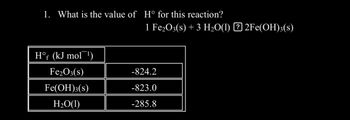
Chemistry: Principles and Reactions
8th Edition
ISBN: 9781305079373
Author: William L. Masterton, Cecile N. Hurley
Publisher: Cengage Learning
expand_more
expand_more
format_list_bulleted
Question
Please correct answer and don't used hand raiting

Transcribed Image Text:1. What is the value of H° for this reaction?
1 Fe2O3(s) + 3 H₂O(1) ? 2Fe(OH)3(s)
Hof (kJ mol ¹)
Fe2O3(s)
-824.2
Fe(OH)3(s)
-823.0
H₂O(1)
-285.8
Expert Solution
This question has been solved!
Explore an expertly crafted, step-by-step solution for a thorough understanding of key concepts.
Step by stepSolved in 2 steps

Knowledge Booster
Similar questions
- 9.96 Most first aid "cold packs" are based on the endothermic dissolution of ammonium nitrate in water: NH4NO3(s)NH4+(aq)+NO3(aq) H= 25.69 kJ A particular cold pack contains 50.0 g of NH4NO3 and 125.0 g of water. When the pack is squeezed, the NH4NO3dissolves in the water. If the pack and its contents are initially at 24.0°C, what is the lowest temperature that this bag could reach? (Assume that the ammonium nitrate solution has a specific heat of 4.25J g-l K-l, and that the heat capacity of the bag itself is small enough to be neglected.)arrow_forwardWhen 7.11 g NH4NO3 is added to 100 mL water, the temperature of the calorimeter contents decreases from 22.1 C to 17.1 C. Assuming that the mixture has the same specific heat as water and a mass of 107 g, calculate the heat q. Is the dissolution of ammonium nitrate exothermic or endothermic?arrow_forward12.67 Hydrofluoric acid is a weak acid used in the building industry to etch patterns into glass for elegant windows. Because it dissolves glass, it is the only inorganic acid that must be stored in plastic containers. A 0.1 M solution of HF has a pH of 2.1. Calculate [Hj0"| in this solution.arrow_forward
- Predict whether each of the following processes results in an increase in entropy in the system. (Define reactants and products as the system.) (a) Water vapor condenses to liquid water at 90 C and 1 atm pressure. (b) The exothermic reaction of Na(s) and Cl2(g) forms NaCl(s). (c) The endothermic reaction of H2 and I2 produces an equilibrium mixture of H2(g), I2(g), and HI(g). (d) Solid NaCl dissolves in water forming a saturated solution.arrow_forwardThe following reaction occurs in pure water: H2O(l)+H2O(l)H3O+(aq)+OH-(aq) which is often abbreviated as H2O(l)H+(aq)+OH-(aq) For this reaction, G = 79.9 kJ/mol at 25C. Calculate the value of G for this reaction at 25C when [OH] = 0.15 M and [H+] = 0.71 M.arrow_forwardConsider the reaction NH4+(aq) H+(aq)+NH3(aq) Use G f for NH3(aq) at 25C=26.7 kJ/mol and the appropriate tables to calculate (a) G at 25C (b) Ka at 25Carrow_forward
- The equilibrium constant for a certain reaction increases by a factor of 6.67 when the temperature is increased from 300.0 K to 350.0 K. Calculate the standard change in enthalpy (H) for this reaction (assuming H is temperature-independent).arrow_forwardConsider the equilibrium system HF(aq)H+(aq)+F(aq) Given HfHF(aq)=320.1kJ/mol , HfF(aq)=332.6kJ/mol ; SF(aq)=13.8kJ/molK ; KaHF=6.9104 at 25°C calculate S° for HF(aq).arrow_forwardWet limestone is used to scrub SO2 gas from the exhaust gases of power plants. One possible reaction gives hydrated calcium sulfite: CaCO3(s) + SO2(g) + H2O() CaSO3 H2O(s) + CO2(g) Another reaction gives hydrated calcium sulfate: CaCO3(s) + SO2(g) + H2O() + O2(g) CaSO4 H2O(s) + CO2(g) (a) Which reaction is more product-favored at equilibrium? Use the data in the table below and any other information needed in Appendix L to calculate rG for each reaction at 25 C. (b) Calculate rG for the reaction CaSO3 H2O(s) + O2(g) CaSO4 H2O(s) Is this reaction product- or reactant-favored at equilibrium?arrow_forward
- Is Ssurr favorable or unfavorable for exothermic reactions? Endothermic reactions? Explain.arrow_forwardWrite a chemical equation for each process and classify each as reactant-favored or product-favored. (a) A puddle of water evaporates on a summer day. (b) Silicon dioxide (sand) decomposes to the elements Silicon and oxygen. (c) Paper, which is mainly cellulose (C6H10O5)n, bums at a temperature of 451 F. (d) A pinch of sugar dissolves in water at room temperature.arrow_forwardSodium chloride is added to water (at 25C) until it is saturated. Calculate the Cl concentration in such a solution. Species G(kJ/mol) NaCl(s) 384 Na+(aq) 262 Cl(aq) 131arrow_forward
arrow_back_ios
SEE MORE QUESTIONS
arrow_forward_ios
Recommended textbooks for you
 Chemistry: Principles and ReactionsChemistryISBN:9781305079373Author:William L. Masterton, Cecile N. HurleyPublisher:Cengage Learning
Chemistry: Principles and ReactionsChemistryISBN:9781305079373Author:William L. Masterton, Cecile N. HurleyPublisher:Cengage Learning Chemistry: Principles and PracticeChemistryISBN:9780534420123Author:Daniel L. Reger, Scott R. Goode, David W. Ball, Edward MercerPublisher:Cengage Learning
Chemistry: Principles and PracticeChemistryISBN:9780534420123Author:Daniel L. Reger, Scott R. Goode, David W. Ball, Edward MercerPublisher:Cengage Learning Chemistry for Engineering StudentsChemistryISBN:9781337398909Author:Lawrence S. Brown, Tom HolmePublisher:Cengage Learning
Chemistry for Engineering StudentsChemistryISBN:9781337398909Author:Lawrence S. Brown, Tom HolmePublisher:Cengage Learning Chemistry & Chemical ReactivityChemistryISBN:9781337399074Author:John C. Kotz, Paul M. Treichel, John Townsend, David TreichelPublisher:Cengage Learning
Chemistry & Chemical ReactivityChemistryISBN:9781337399074Author:John C. Kotz, Paul M. Treichel, John Townsend, David TreichelPublisher:Cengage Learning ChemistryChemistryISBN:9781305957404Author:Steven S. Zumdahl, Susan A. Zumdahl, Donald J. DeCostePublisher:Cengage Learning
ChemistryChemistryISBN:9781305957404Author:Steven S. Zumdahl, Susan A. Zumdahl, Donald J. DeCostePublisher:Cengage Learning Chemistry: An Atoms First ApproachChemistryISBN:9781305079243Author:Steven S. Zumdahl, Susan A. ZumdahlPublisher:Cengage Learning
Chemistry: An Atoms First ApproachChemistryISBN:9781305079243Author:Steven S. Zumdahl, Susan A. ZumdahlPublisher:Cengage Learning

Chemistry: Principles and Reactions
Chemistry
ISBN:9781305079373
Author:William L. Masterton, Cecile N. Hurley
Publisher:Cengage Learning

Chemistry: Principles and Practice
Chemistry
ISBN:9780534420123
Author:Daniel L. Reger, Scott R. Goode, David W. Ball, Edward Mercer
Publisher:Cengage Learning

Chemistry for Engineering Students
Chemistry
ISBN:9781337398909
Author:Lawrence S. Brown, Tom Holme
Publisher:Cengage Learning

Chemistry & Chemical Reactivity
Chemistry
ISBN:9781337399074
Author:John C. Kotz, Paul M. Treichel, John Townsend, David Treichel
Publisher:Cengage Learning

Chemistry
Chemistry
ISBN:9781305957404
Author:Steven S. Zumdahl, Susan A. Zumdahl, Donald J. DeCoste
Publisher:Cengage Learning

Chemistry: An Atoms First Approach
Chemistry
ISBN:9781305079243
Author:Steven S. Zumdahl, Susan A. Zumdahl
Publisher:Cengage Learning